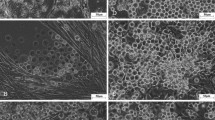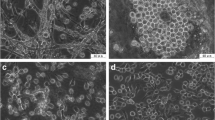Abstract
The midgut of lepidopteran larvae serves as a target for many pathogens such as Bacillus thuringiensis (Bt). Cell lines originating from midgut tissues will be very helpful tools in many research fields. However, to date, no Bt-susceptible midgut-derived cell lines are available. Here, we reported that a novel cell line, designated as HNU-Ha-MG1, was established from midgut tissue of the fourth instar larvae of Helicoverpa armigera. This cell line grew well in Grace’s insect cell culture medium supplemented with 10−15% fetal bovine serum. The shape of the most cells was round or polygonal, and some tended to aggregate to form multiple cell masses. The size of the cells was 13.8 ± 1.8 μm in diameter, and the maximum density reached (2.40 ± 0.15) × 106 cells/ml. The population doubling time during logarithmic growth phase was 58.6 ± 7.0 h at 28°C. The number of chromosomes was about 90–130, which exhibited typical chromosome characteristics of lepidopteran cell lines. The patterns of random amplified polymorphic DNA of the cell line were different from those of Sl-HP and Hi5 cell lines which were frequently used in our laboratory. 20-Hydroxyecdysterone induced apoptosis in a very small part of cells at 2 μg/ml but did not affect expression of autophagy-related protein 8 (Atg8) and its lipidation at 36 h post-treatment. The cell line was permissive to Autographa californica nuclear polyhedrosis virus (AcMNPV) and H. armigera nuclear polyhedrosis virus (HaSNPV). This cell line was found to be susceptible to activated Cry1C at the final concentration of 0.5−1.0 μg/ml but not to the activated Cry1Ac.








Similar content being viewed by others
References
Aljabr AM, Rizwan-ul-Haq M, Hussain A, Al-Mubarak AI, AL-Ayied HY (2014) Establishing midgut cell culture from Rhynchophorus ferrugineus (Olivier) and toxicity assessment against ten different insecticides. In Vitro Cell Dev Biol Anim 50:296–303
Billingsly PF, Lehane MJ (1996) Structure and ultrastructure of the insect midgut. In: Lehane MJ, Billingsly PF (eds) Biology of the insect midgut. Chapman and Hall, London, pp 31–54
Castagnola A, Jurat-Fuentes JL (2009) Resistance to Cry toxins and epithelial healing. IOBC/WPRS Bull 45:27–32
Ding W, Feng Y, Zhang X, Li X, Wang C (2013) Establishment and characterization of a cell line developed from the neonate larvae of Papilio demoleus Linnaeus (Lepidoptera: Papilionidae). In Vitro Cell Dev Biol Anim 49:108–113
Disney JE, McCarthy WJ (1985) A modified technique for the improved characterization of lepidopteran chromosomes from cells in culture. In Vitro Cell Dev Biol 21:563–568
Gai Z, Zhang X, Islam M, Wang X, Li A, Yang Y, Li Y, Peng J, Hong H, Liu K (2013) Characterization of atg8 in lepidopteran insect cells. Arch Insect Biochem Physiol 84:57–77
Garcia JJ, Li G, Wang P, Zhong J, Granados RR (2001) Primary and continuous midgut cell cultures from Pseudaletia unipuncta (Lepidoptera: Noctuidae). In Vitro Cell Dev Biol Anim 37:353–359
Goodman CL, Stanley D, Ringbauer JA, Beeman RW, Silver K, Park Y (2012) A cell line derived from the red flour beetle Tribolium castaneum (Coleoptera: Tenebrionidae). In Vitro Cell Dev Biol Anim 48:426–433
Goodman CL, Wang AA, Nabli H, McIntosh AH, Wittmeyer JL, Grasela JJ (2004) Development and partial characterization of Heliothine cell lines from embryonic and differentiated tissues. In Vitro Cell Dev Biol Anim 40:89–94
Grace TDC (1962) Establishment of four strains of cells from insect tissues grown in vitro. Nature 195:788–789
Grasela JJ, McIntosh AH, Ringbauer J Jr, Goodman CL, Carpenter JE, Popham HJR (2012) Development of cell lines from the cactophagous insect: Cactoblastis cactorum (Lepidoptera: Pyralidae) and their susceptibility to three baculoviruses. In Vitro Cell Dev Biol Anim 48:293–300
Hakim RS, Caccia S, Loeb M, Smagghe G (2009) Primary culture of insect midgut cells. In Vitro Cell Dev Biol Anim 45:106–110
Hu J, Feng X, Yang Z, Chen Z, Zhang W (2014) A continuous cell line, SYSU-OfHe-C, from hemocytes of Ostrinia furnacalis possesses immune ability depending on the presence of larval plasma. Dev Comp Immunol 45:10–20
Imanishi S, Kobayashi J, Sekine T (2012) Serum-free culture of an embryonic cell line from Bombyx mori and reinforcement of susceptibility of a recombinant BmNPV by cooling. In Vitro Cell Dev Biol Anim 48:137–142
Kharat KR, Sawant MV, Peter S, Hardikar BP (2010) Development and characterization of new cell line BPH22 from midgut epithelial cells of Poekilocerus pictus (Fabricius, 1775). In Vitro Cell Dev Biol Anim 46:824–827
Kolokol‘tsova TD, Gerasimova NG, Tsareva AA (1995) A new cell line from Heliothis armigera (Hubn.) pupa ovaries. Vopr Virusol 40:135–138
Léry X, LaRue B, Cossette J, Charpentier G (2003) Characterization and authentication of insect cell lines using RAPD markers. Insect Biochem Mol Biol 33:1035–1041
Liu K, Li Y, Jousset FX, Zadori Z, Szelei J, Yu Q, Pham HT, Lépine F, Bergoin M, Tijssen P (2011) The AdDNV densovirus of the European house cricket, Acheta domesticus, evolved a unique expression strategy among parvoviruses. J Virol 85:10069–10078
Lynn DE (2001) Novel techniques to establish new insect cell lines. In Vitro Cell Dev Biol Anim 37:319–321
Lynn DE, Goodman C, Caputo G (2005) Techniques for the development of new insect cell lines. Proc 2005 Annual Meet Soc In Vitro Biology, Baltimore, MD, USA
Martins GF, Neves CA, Campos LAO, Serraö JE (2006) The regenerative cells during the metamorphosis in the midgut of bees. Micron 37:161–168
Mclntosh AH, Ignoffo CM, Chen QH, Papas M (1983) Establishment of a cell line from Heliothis armigera (Hubn.) (Lepidoptera: Noctuidae). In Vitro 19:589–590
Mena JA, Ramírez OT, Palomares LA (2003) Titration of non-occluded baculovirus using a cell viability assay. BioTechniques 34:260–264
Mitsuhashi J, Grace TDC (1970) The effects of insect hormones on the multiplication rates of cultured insect cells in vitro. Appl Entomol Zool 5:182–188
Nardi JB, Bee CM (2012) Regenerative cells and the architecture of beetle midgut epithelia. J Morphol 273:1010–1020
Park Y, González-Martínez RM, Navarro-Cerrillo G, Chakroun M, Kim Y, Ziarsolo P, Blanca J, Cañizares J, Ferré J, Herrero S (2014) ABCC transporters mediate insect resistance to multiple Bt toxins revealed by bulk segregant analysis. BMC Biol 12:46
Pringle FM, Johnson KN, Goodman CL, McIntosh AH (2003) Providence virus: a new member of the Tetraviridae that infects cultured insect cells. Virology 306:359–370
Rost-Roszkowska MM, Poprawa I, Klag J, Migula P, Mesjasz-Przybyłowicz J, Przybyłowicz W (2008) Degeneration of the midgut epithelium in Epilachna cf. nylanderi (Insecta, Coccinellidae): apoptosis, autophagy, and necrosis. Can J Zool 86:1179
Rost-Roszkowska MM, Poprawa I, Klag J, Migula P, Mesjasa-przybyocicz J, Przybyowicz W (2010) Differentiation of regenerative cells in the midgut epithelium of Epilachna cf. nylanderi (Mulsant 1850) (Insecta, Coleoptera, Coccinellidae). Folia Biol (Kraków) 58:209–216
Sadrud-Din SY, Hakin RS, Loeb MH (1994) Proliferation and differentiation of midgut epithelial cells from Manduca sexta, in vitro. Invertebr Reprod Dev 26:197–204
Shao HL, Zheng WW, Liu PC, Wang Q, Wang JX, Zhao XF (2008) Establishment of a new cell line from Lepidopteran epidermis and hormonal regulation on the genes. PLoS ONE 3:e3127
Shih CJ, Lin RW, Wang CH (1997) Establishment of a cell line from Spodoptera litura (Lepidoptera: Noctuidae) and replication of S. litura nuclear polyhedrosis virus in vitro. J Invertebr Pathol 69:1–6
Smagghe G, Tirry L (2001) Insect midgut as a site for insecticide detoxification and resistance. In: Ishaaya I (ed) Biochemical sites of insecticide action and resistance. Springer, Berlin, pp 293–321
Sohi SS, Lalouette W, Macdonald JA, Gringorten JL, Budau CB (1993) Establishment of continuous midgut cell lines of spruce budworm (Lepidoptera: Tortricidae). In Vitro Cell Dev Biol 29A:56A
Sohi SS, Pall SR, Cook BJ, Retnakaran A (1995) Forest insect cell lines responsive to 20-hydroxyecdysone and two nonsteroidal ecdysone agonists, RH-5849 and RH-5992. J Insect Physiol 41:457–464
Su DM, Shen ZJ, Yue YX (1987) Establishment of an ovarian cell line in the cotton bollworm Heliothis armigera and in vitro replication of its cytoplasmic polyhedrosis. In: Maramorosh K (ed) Biotechnology in invertebrate pathology and cell culture. Academic, New York, pp 375–383
Sudeep AB, Mourya DT, Mishra AC (2005) Insect cell culture in research: Indian scenario. Indian J Med Res 121:725–738
Sudeep AB, Mourya DT, Shouche YS, Pidiyar V, Pant U (2002a) A new cell line from the embryonic tissue of Helicoverpa armigera Hǜbn. (Lepidoptera: Noctuidae). In Vitro Cell Dev Bio Anim 38:262–264
Sudeep AB, Shouche YS, Mourya DT, Pant U (2002b) New Helicoverpa armigera Hǜbn cell line from larvae hemocyte for baculovirus studies. Indian J Exp Biol 40:69–73
Summers MD, Smith GE (1987) A manual of methods for baculovirus vectors and insect cell culture procedures. Tex Agric Exp Station Bull 1555:1–56
Xu P, Islam M, Xiao Y, He F, Li Y, Peng J, Hong H, Liu K (2014) Expression of recombinant and mosaic Cry1Ac receptors from Helicoverpa armigera and their influences on the cytotoxicity of activated Cry1Ac to Spodoptera litura Sl-HP cells. Cytotechnology 1–16. doi:10.1007/s10616-014-9801-5
Zhang H, Zhang YA, Qin Q, Wang Y, Li X, Miao L, Yin Z, Zhang A, Qu L, Ding C (2006) A new cell line from larvae fat bodies of the bollworm, Helicoverpa armigera (Lepidoptera: Noctuidae). In Vitro Cell Dev Biol Anim 42:290–293
Zhang N, Qin Q, Gong H, Meng Q, Zhu W, Wang M, Zhang J, Zhou G, Li X (2014) A new insect cell line from the pupal ovary of the Asian corn borer moth Ostrinia furnacalis. In Vitro Cell Dev Biol Anim 50:171–173
Zhang X, Lan W, Deng Y, Ma Y, Liu K, Peng J, Hong H (2008) Highly passage of Spodoptera litura cell line causes its permissiveness to baculovirus infection. Cytotechnology 57:233–243
Zheng GL, Li CY, Zhou HX, Li SW, Li GX, Xue M (2010) Establishment of two new cell lines from the embryonic tissues of Helicoverpa armigera (Lepidoptera: Noctuidae) and their responses to baculovirus infection. Acta Entomol Sin 53:167–174
Zheng G, Li M, Li C (2014) Establishment and characterization of three new cell lines from the embryonic tissue of Holotrichia oblita Faldermann (Coleoptera: Scarabaeidae). In Vitro Cell Dev Biol Anim 50:483–488
Acknowledgment
This study was financially supported by the grant from the National Natural Science Foundation of China (31071739 and 31372260).
Author information
Authors and Affiliations
Corresponding author
Additional information
Editor: T. Okamoto
Rights and permissions
About this article
Cite this article
Li, J., He, F., Yang, Y. et al. Establishment and characterization of a novel cell line from midgut tissue of Helicoverpa armigera (Lepidoptera: Noctuidae). In Vitro Cell.Dev.Biol.-Animal 51, 562–571 (2015). https://doi.org/10.1007/s11626-015-9870-6
Received:
Accepted:
Published:
Issue Date:
DOI: https://doi.org/10.1007/s11626-015-9870-6




